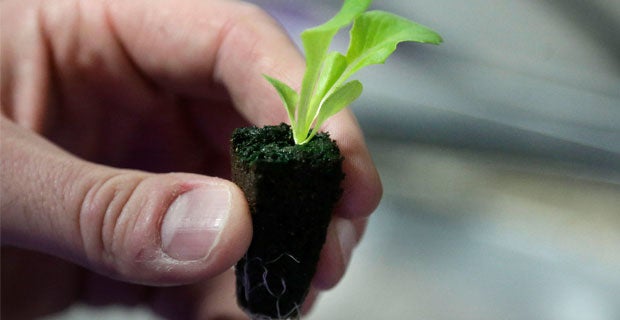Seed starting time is almost here!
Listen 00:52:58Seed starting time is fast approaching! Mike McGrath, host of You Bet Your Garden, will review the basics of growing your own plants, with a focus on proper feeding. Plus your fabulous phone calls!
Question of the Week:
“I’ll be starting basil and tomatoes under some LED fixtures that I can adjust to keep the lights just above the plants. I’ll use a timer to provide the appropriate amount of light each day (which I still need to research). My question is about feeding. I’ve heard you say that potting soil has almost no nutrients. So how should I feed my young plants? Once they’re outside, I’ll use my own compost (made from fall leaves), but I don’t want to use it inside the house. Is there some kind of granular feed you would recommend?”
— Tyler in Harleysville PA
Learn more about feeding baby plants »
Highlights from show:
Hemlock Trees
Michelle, in Haines, Alaska, has a question about her hemlock trees. The trees tend to filter and block sunlight from her property, and sunlight is very valuable during those long, dark, Alaskan winters. She has tried to trim the trees back, but is afraid to damage them. With the fluctuating winter temperatures, it is hard to tell if these hemlock trees are dormant. If Michelle prunes them when they’re too warm, the trees will bleed. Mike advises to prune the trees a little at a time, but only during cold weather. He says it is best to do the trimming a day or two into a cold snap.
Coffee Grounds in Fertilizer
David, in Philadelphia, Pennsylvania, collects discarded houseplants, and wants to know if he can utilize his used coffee grounds to fertilize these plants. Mike says that coffee grounds are very rich in nitrogen, which is the primary plant food. Nitrogen is best used in bulk on plants that do not flower. Also, coffee grounds are slightly acidic, though there’s no consensus on just how acidic they are. Houseplants, Mike says, do not need a lot of food, especially in the winter, and overfeeding houseplants can hurt them.
Potted Orchid
Fran, in Philadelphia, Pennsylvania, has a small orchid plant in a 3- or 4-inch pot. It’s just the kind that you could buy at a local market. It’s white with a yellow center. She is concerned because its leaves are wilting and wrinkling. Fran’s orchid is a basic moth orchid or phalaenopsis, and she keeps it in her laundry room about 2 feet beneath fluorescent tube lighting. Mike says that this is not necessary, and informs Fran that orchids are epiphytes. Epiphytes wrap around the roots and trunks of trees in very dark, damp areas. Mike says these plants like warmth and very ambient, subtle light.
Hackberry Trees
Andrew from Madison, Tennessee has several hackberry trees on his property. In the front of the yard, he has a huge one that is overgrown with ivy. He’s hacked at it and the vine just keeps coming back. Lee says to just keep an eye on it, and keep hacking away gently. All three suggest to get the ivy out of the tree, which will be beneficial for its growth and health.
Snowy Azaleas
David, in Indianapolis, Indiana, has a question about his former azalea bush. In the winter, when it snowed, he would brush the snow off the bush to prevent the branches from breaking under the weight of the heavy snow. Now, his father is in possession of the bush, and David is worried his father won’t remember to tend to the azaleas during the winter. He wants to know if this kind of maintenance is really necessary. Mike says that the plant has enough room between the branches to endure the snow, and that trying to brush the snow off might damage the plant more.
Eventually, David wants to transport this 15- to 20-year-old azalea bush to his new home. David wants to know how to move it. Mike advises to trim the plant back by a third just after it has completely flowered. Then, Mike says, David needs to shovel the plant out of the ground with the roots in-tact. To do this, Mike says, David has to dig deep and wide around the plant. Mike also advises to protect the plant from the wind. Alternatively, Mike suggests taking cuttings from the plant and trying to root them.
Tropical Salvias
Linda, in Kimberton, Pennsylvania, has a few tropical salvias. This year, Linda says she only had flowers for two weeks because they bloomed late and then an early frost came. So, Linda decided to bring her plants inside. To her surprise, they started sprouting in her warm basement. She waters them lightly and loves them well, but doesn’t know how much to water them. Mike tells us that salvia is another name for sage. He says sages/salvias are winter hardy. You can leave them out year after year. Linda says they don’t usually return after the winter. Mike says that, like pepper plants, salvias are perennial if they are protected from frost. Mike suggests that Linda grow them in containers, keep them outside in the warm weather, and bring them inside during the winter. He advises Linda to purchase 4-foot-long fluorescent lighting tubes, hang them on top of a table in her warm basement, and place the salvia right under these lights. Mike says, under these conditions, the salvia should flower all winter, eventually growing into small trees.
WHYY is your source for fact-based, in-depth journalism and information. As a nonprofit organization, we rely on financial support from readers like you. Please give today.


